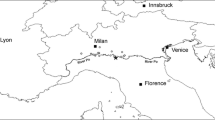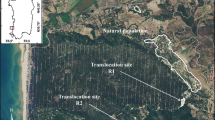Abstract
Reintroduction programs are often initiated to restore the viability of endangered plant populations, whose decline is usually caused by loss of suitable habitats. Ligularia sibirica is a species associated with wetlands. It is endangered in Europe and has declined considerably in Estonia since the cessation of traditional management and, in addition, drainage leading to the overgrowth of habitats. The purpose of this work was to estimate the extent of the impact of competition from neighbouring plants and habitat change caused by overgrowing on the survival of transplants of L. sibirica and thereby assess the effectiveness of reinforcement. Laboratory-grown transplants were planted back into their original populations in plots arranged in a two × two (vegetation intact or removed × open or overgrown habitat) factorial experimental design, and their survival was followed for three years. The survival differed notably among populations, but the percentage of surviving plants per plot was on average higher in plots with intact vegetation and in open habitats. The latter indicates that overgrowing indeed decreases habitat quality for this species, despite the fact that plants of L. sibirica can often be found in forested habitats. The lower survival in plots where vegetation had been removed can largely be explained by increased damage caused by animals. In intact plots, by contrast, neighbouring plants provide shelter and protection. Our results stress the importance of restoration and preservation of habitat quality for the protection of this rare species, for which reinforcement may be effective.


Similar content being viewed by others
References
Aguilar R, Ashworth L, Galetto L, Aizen MA (2006) Plant reproductive susceptibility to habitat fragmentation: review and synthesis through a meta-analysis. Ecol Lett 9:968–980
Bertness M, Callaway RM (1994) Positive interactions in communities. Trends Ecol Evol 9:191–193
Bottin L, Le Cadre S, Quilichini A, Bardin P, Moret J, Machon N (2007) Re-establishment trials in endangered plants: a review and the example of Arenaria grandiflora, a species on the brink of the extinction in the Parisian region (France). Ecoscience 14:410–419
Brook BW, Sodhi NS, Bradshaw CJA (2008) Synergies among extinction drivers under global change. Trends Ecol Evol 23:453–460
Brooker RW, Maestre FT, Callaway RM, Lortie CL, Cavieres LA, Kunstler G, Liancourt P, Tielbörger K, Travis JMJ, Anthelme F, Armas C, Coll L, Corcket E, Delzon S, Forey E, Kikvidze Z, Olofsson J, Pugnaire F, Quiroz CL, Saccone P, Schiffers K, Seifan M, Touzard B, Michalet R (2008) Facilitation in plant communities: the past, the present, and the future. J Ecol 96:18–34
Callaway RM, Walker LR (1997) Competition and facilitation: a synthetic approach to interactions in plant communities. Ecology 78:1958–1965
Cavieres L, Arroyo MTK, Penaloza A, Molina-Montenegro M, Torres C (2002) Nurse effect of Bolax gummifera cushion plants in the alpine vegetation of the Chilean Patagonian Andes. J Veg Sci 13:547–554
Drayton B, Primack RB (2000) Rates of success in the reintroduction by four methods of several perennial plant species in eastern Massachusetts. Rhodora 102:299–331
Falk DA, Millar CI, Olwell M (1996) Restoring diversity. In Falk DA, Millar CI, Olwell M (eds) Strategies for reintroduction of endangered plants. Island Press, Washington DC, pp XIII–XXII
Fischer J, Lindenmayer DB (2007) Landscape modification and habitat fragmentation: a synthesis. Global Ecol Biogeogr 16:265–280
Godefroid S, Piazza C, Rossi G, Buord S, Stevens A-D, Aguraiuja R, Cowell C, Weekley CW, Vogg G, Iriondo JM, Johnson I, Dixon B, Gordon D, Magnanon S, Valentin B, Bjureke K, Koopman R, Vicens M, Virevaire M, Vanderborght T (2011) How successful are plant species reintroductions? Biol Conservation 144:672–682
Grace JB, Tilman D (1990) Perspectives on plant competition. Academic Press, San Diego
Griffith B, Scott JM, Carpenter JW, Reed C (1989) Translocation as a species conservation tool: status and strategy. Science 245:477–480
Guerrant EO, Kaye TN (2007) Reintroduction of rare and endangered plants: common factors, questions and approaches. Austral J Bot 55:362–370
Harper J (1977) The population biology of plants. Academic Press, London
Hegi G (1987) Illustrierte Flora von Mitteleuropa. Teil 4. Verlag Paul Parey, Berlin und Hamburg
Hobbs RJ, Yates CJ (2003) Impacts of ecosystem fragmentation on plant populations: generalising the idiosyncratic. Austral J Bot 51:471–488
Hölzel N, Buisson E, Dutoit T (2012) Species introduction – a major topic in vegetation restoration. Appl Veg Sci 15:161–165
Hultén E, Fries M (1986) Atlas of North European vascular plants: North of the Tropic of Cancer. Koeltz Scientific Books, Köningstein
Ilves A, Lanno K, Sammul M, Tali, K (2013) Genetic variability, population size and reproduction potential in Ligularia sibirica (L.) populations in Estonia. Conservation Genet 14:661–669
Jusaitis M (2005) Translocation trials confirm specific factors affecting the establishment of three endangered plant species. Ecol Managem Restoration 60:61–67
Kaye TN (2002) Reintroducing the endangered Pink Sand-verbena to Pacific Coast beaches: direct seeding and out-planting. In Brooks MB, Carothers SK, LaBanca T (eds) The ecology and management of rare plants of northwestern California. Proceedings from Symposium North Coast Chapter California Native Plant Society, California Native Plant Society, Sacramento, pp 131–140
Kaye TN, Brandt A (2005) Seeding and transplanting rare Willamette Valley prairie plants for population restoration. Technical report prepared for the Eugene District, USDI Bureau of Land Management and Institute of Applied Ecology, Corvalis, Oregon
Kukk Ü (2003) The distribution of Ligularia sibirica (L.) Cass. in Estonia and changes in its population. Biul Ogrodów Bot 12:11–22
McKendrick SL (1995) The effects of herbivory and vegetation on laboratory-raised Dactylorhiza praetermissa (Orchidaceae) planted into grassland in southern England. Biol Conservation 73:215–220
Menges ES (2008) Restoration demography and genetics of plants: when is a translocation successful? Austral J Bot 56:187–196
Midoko-Iponga D, Krug C, Milton SJ (2005) Competition and herbivory influence growth and survival of shrubs on old fields: implications for restoration of renosterveld shrubland. J Veg Sci 16:685–692
Milton SJ, Bond WJ, du Plessis MA, Gibbs D, Hilton-Taylor C, Linder HP, Raitt L, Wood J, Donaldson JS (1999) A protocol for plant conservation by translocation in threatened lowland Fynbos. Conservation Biol 13:735–743
Pavlik BM (1996) Defining and measuring success. In Falk DA, Millar CI, Olwell M (eds) Strategies for reintroduction of endangered plants. Island Press, Washington DC, pp 127–155
Sammul M, Oksanen L, Mägi M (2006) Regional effects on competition-productivity relationship: a set of field experiments in two distant regions. Oikos 112:138–148
StatSoft, Inc. (2010) STATISTICA (data analysis software system), version 9.1. Available at: http://www.statsoft.com
Van der Wal R, Egas M, van der Veen A, Bakker J (2000) Effects of resource competition and herbivory on plant performance along a natural productivity gradient. J Ecol 88:317–330
Vitousek PM, Mooney HA, Lubchenko J, Melillo JM (1997) Human domination of Earth’s ecosystems. Science 277:494–499
Acknowledgments
We thank all the people who helped with the lab- and field work (especially Thea Kull, Karin Kaljund, and Silja Kana) and Roger Evans for doing a language revision. Two anonymous reviewers provided useful comments on this manuscript. We appreciate the help from the herbarium of vascular plants and mosses (TAA) of Estonian University of Life Sciences. This work was funded by a species protection programme of the Estonian Environmental Board and by grant No. 8745 from the Estonian Science Foundation.
Author information
Authors and Affiliations
Corresponding author
Rights and permissions
About this article
Cite this article
Lanno, K., Sammul, M. The Survival of Transplants of Rare Ligularia sibirica is Enhanced by Neighbouring Plants. Folia Geobot 49, 163–173 (2014). https://doi.org/10.1007/s12224-013-9163-3
Received:
Revised:
Accepted:
Published:
Issue Date:
DOI: https://doi.org/10.1007/s12224-013-9163-3




